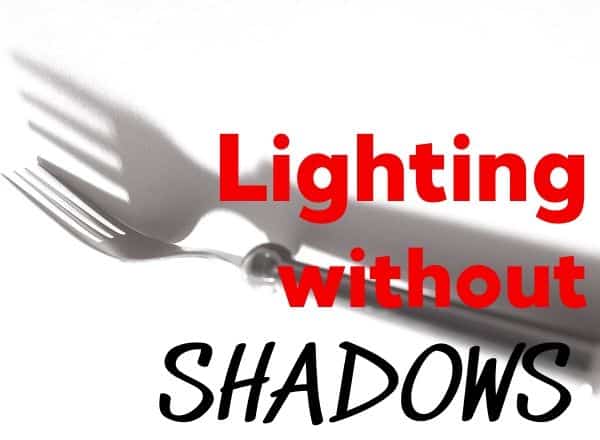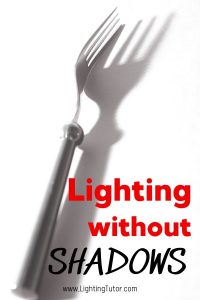Last Updated on April 10, 2020 by The Tutor
Lighting Without Shadows

It does not matter whether you are lighting a room in your home or if you are a photographer struggling to remove shadows from view, lighting without shadows can be challenging but there are various techniques that can help.
In this article, you will find tips on how to light a room without shadows and also how to photograph an object with a background without casting a shadow. Keep in mind what we discuss below will not completely eliminate the shadows but will significantly reduce them.
5 Steps to Lighting Without Shadows
There are three basic steps to lighting a room without shadows. Your ability to reduce shadows in a doom will depending upon the size of your room, the number and size of the objects in the room that could cast a shadow, and also your lighting budget.
- Place Lights High – The higher the lighting in the room, the less it will cast a shadow. If there are shadows, they will be directed more in a downward direction towards the floor. Recessed lighting is the optimal choice to reduce lighting.
- Increase the number of lights – The more lights you have in the room, the fewer shadows there will be. It comes down to surrounding every object in the room with an even amount of light so that you do not see the shadows.
- Larger lights – If you use larger light fixtures, there will be fewer shadows. This means no micro-recessed lights for example. Their light beams are much too pin pointed. Look for the widest light cans (6 inch if possible) that you can find.
- Lighting with diffusers – Many of the recessed lighting fixtures now come with a frosted cover over the bulb that is diffusing the light. This is what you need and you do not want to see an actual bulb. If you are using lamps in a room to complement the recessed lighting, then try to use lamp shades that also diffuse light.
- Light colors on the walls – Using lighter colors on the wall will do two things. First, it will help eliminate the appearance of shadows. Second, the lighter colored walls will bounce light back towards the objects that would be creating shadows.
Lighting a Kitchen Without Shadows 
When you are laying out your kitchen lighting plan, think about how to eliminate shadows. Two of the typical areas where shadows are created would be just below the kitchen cabinets and also at your center island when pendants are being used.
The first thing you need to do is fill the room with light using recessed lighting. If you are concerned about shadows, then the outer most fixtures should be positioned right above the edge of the cabinet so you don’t create the shadow when you are standing there preparing food.
If there are recessed lights are positioned directly above the counter, then you will need to also add under cabinet lighting to completely light the area beneath the cabinets. This will provide for an even amount of light if you place the under cabinet lights strategically.
Next are the pendant lights that have become very popular to use over kitchen islands. These are often installed too low and there are not enough of them. This becomes a problem when they are not used in conjunction with recessed lighting.
Your pendants should be more decorative and should provide accent lighting only if you are attempting to eliminate shadows. They should always be used in combination with recessed lighting.
Lighting a Bathroom Without Shadows
Shadows in a bathroom become a problem at the vanity when you are seeing shadows on your face in front of the mirror. The best way to explain how to eliminate this situation is to surround yourself with light. Provide lighting in all directions if at all possible.
As always, when lighting a bathroom you are starting with recessed lighting. Although bathrooms are often small and you may be tempted to use just one or two recessed lights, consider adding a bit more but with fewer lumens each so you are providing an even amount of light but not too much light.
The next most important tip is to provide adequate lighting to the left and the right of the bathroom vanity or mirror. If you are looking for the right light to apply makeup, the vanity should have lights just above the mirror but also to the sides and also below if possible.
If your vanity only has lighting at the top, then you can add two wall sconces on either side but select one that is more functional than it is decorative. Consider replacing your vanity with one that is specifically designed for applying makeup.
Lighting a Home Office Without Shadows
Eliminating shadows in a home office may be a bit more difficult than some of the other rooms in the home. This is because there is the tendency to add lamps to illuminate the keyboard and work space. When one lamp is used, it will definitely result in shadows on the other side of your desk.
One strategy is to add taller lamps on either side of your work space. This will help eliminate most of the shadows immediately. If you have the budget, this lamp featured below is known to reduce shadows as well. Although it is pricey, you can use just this one since it can be positioned directly over your work space.
Check Price on Amazon – Also available in white
Eliminating Shadows While Photographing Against a Background
If you are a photographer who pays very close attention to shadows, then this topic is probably something that drives you crazy. There are plenty of forums and many experts who have provided advice in some of the forums and photography specific blogs.
Here is the summary of what can be done to eliminate shadows from your background:
High Lights – Lighting should be higher than the subject to direct any shadows downward and hopefully out of view from the camera.
Strategic Positioning – position lights high above and in front of the subject, but also behind. Lighting the area behind the subject will reduce the shadow created by the light positioned in front. The more lights at different angles, the better. You may need to test various light positions depending upon the subject and distance from the camera.
Distance – Test the distance of the subject from the backdrop. The farther away, the less you will see a shadow. Also, test distance of the light source and the camera lens from the subject being photographed. The farther away, the less you may see shadows. If the camera needs to be close, then try pulling the lights farther away.
Diffused light – Always use a light diffuser but I think for most photographers this is obvious anyway.
Backdrop – The color of your backdrop may also help to eliminate shadows. Try using a dark backdrop to eliminate shadows. If you trying to eliminate shadows on a wall, then you may not have the ability to change the color and your light positioning will be that much more important.
In the end, photography is a science and you need to have constant testing. As you introduce or remove an ingredient or factor, the shadows will change. Your environment may yield different results so use the tips above in various combinations to see what works best for you.
Related Articles
Kelvin Color Temperature Scale – Although you may be trying to remove shadows, you should still be using the best light temperature.
How to Choose the Right Light Bulb – This article makes sense of all of the light bulb options on the market.

